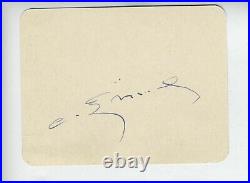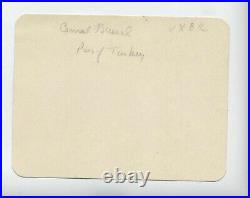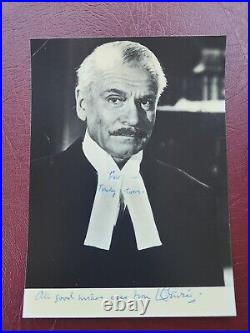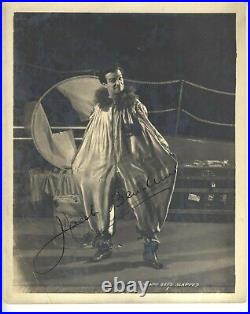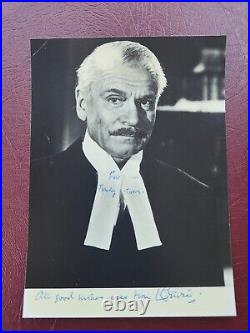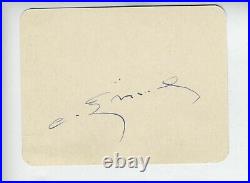
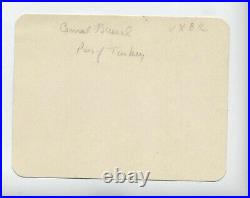

A VERY RARE VINTAGE ORIGINAL AUTOGRAPH OF. Former President of Turkey ON APPROXIMATELY 3X4 CARD. Cemal Gürsel Turkish: d? Sæl; 13 October 1895 – 14 September 1966 was a Turkish army general who became the fourth President of Turkey after a coup. [citation needed] After the elementary school in Ordu and the military middle school in Erzincan, he graduated from the Kuleli military high school in Istanbul. He was a popular figure and was therefore nicknamed “Cemal Aga” (big brother Cemal) since his childhood school years and onwards all his life. Gürsel served in the Army for 45 years. During World War I, he participated in the Battle of Çanakkale in Dardanelles, Gallipoli as a lieutenant with the First Battery of the 12th Artillery Regiment in 1915 and received the War Medal. He later fought at the Palestine and Syria fronts in 1917 and became a prisoner of war by the British while suffering malaria during his command of the 5th Battery of the 41st Regiment on 19 September 1918. Gürsel was kept as a prisoner of war in Egypt until 6 October 1920. During his presidency much later, when interviewed by the foreign press as to why he had not learned English during his captivity, he somewhat regretfully recalled that he was so frustrated to be a captive, he protested and studied French in the British camp instead. He was promoted for gallantry in the First Division excelling in the battles of Second Inönü, Eskisehir and Sakarya, and was later awarded the Medal of Independence by the first Parliament for his combat service in the Final Offensive. Gürsel was married, in 1927, to Melahat, the daughter of the chief engineer on the Ottoman cruiser Hamidiye. From this marriage, a son Özdemir was born. The couple adopted a daughter Türkan. Cemal Gürsel attended the Turkish Military College and graduated in 1929 as a staff officer. He was promoted colonel in 1940. He was made a brigadier general in 1946 and made commander of the 65th Division. He was later the commander of the 12th Division, the 18th Corps commander, and commander of the 2nd Interior Tasks District. Made Lieutenant general in 1953, was general in 1957, being appointed Commander of 3rd Army. Service included chief of intelligence, and he was appointed as the Commander of Land Forces in 1958 when he was commanding an army. Gürsel, as an easy-going and fatherly figure with a fine sense of humor, was well liked both nationally and in NATO circles, and had earned the respect and confidence of both the nation and the armed forces with his professional knowledge and demeanor. A patriotic memorandum he sent on 3 May 1960 to the Minister of Defense in an effort to establish checks and balances on ongoing affairs, reflecting his personal views in continuation of the chat they had the night before, expressing his support to the prime minister Adnan Menderes and belief that the Prime Minister should replace the President with immediate effect to bolster a much needed national unity, resulted in his suspension from his post, forcing early retirement instead of becoming the next Chief of the Turkish General Staff. A farewell letter by him, advocating and urging the army to stay out of politics, was forwarded to all units of the armed forces at the time of his departure on leave. Cemal Gürsel’s statement read:’Always hold high the honor of the army and the uniform you wear. Protect yourselves from the current ambitious and harmful political atmosphere in the country. Stay away from the politics at all cost. This is of utmost importance to your honor, the army’s might and the future of the country. He went to Izmir where he became the president of the Anti-Communism Association of Turkey. See also: 1960 Turkish coup d’état. A coup d’état organised and conducted by army officers at the rank of colonels and below took place without the participation or leadership of Cemal Gürsel on 27 May 1960 after continuing civilian and academia unrests throughout the country. It is rumored that four-star general Ragip Gümüspala, the Commander of the Third Army based in Eastern Anatolia, gave an ultimatum to the rebelling officers that if they did not have a general appointed as their head, the Third Army would attack to take over the capital and the administration of the country, thereby forcing the rebel group to find a senior officer over them. Because of his immense popularity among the public and military ranks, Gürsel was subsequently chosen by the revolutionaries overnight and brought into the chairmanship of the military coup and became, as of 2015, the only leader in the world put into power by a military takeover who had previously had no role in its planning or execution. He, while still in his pajamas, was escorted to Ankara in the military C-47 transport plane by a captain who was the youngest officer of the radical coup team who that by that time had already sent President Celal Bayar, Prime Minister Adnan Menderes, Chief of General Staff Rüstü Erdelhun and some other members of the ruling Democratic Party to a military court on Yassiada in the Sea of Marmara, accusing them of violation of the constitution. The day after the coup, four-star general Cemal Gürsel was declared the commander in chief, Head of state, Prime minister and Minister of Defense of the 24th government on 30 May 1960, in theory giving him more absolute powers than even Kemal Atatürk had ever had. Gürsel freed 200 students and nine newsmen, and licensed 14 banned newspapers to start publishing again (Time, 6 June 1960). He fetched ten law professors, namely Siddik Sami Onar, Hifzi Veldet Velidedeoglu, Ragip Sarica, Naci Sensoy, Hüseyin Nail Kubali, Tarik Zafer Tunaya, Ismet Giritli, Ilhan Arsel, Bahri Savci and Muammer Aksoy, accompanied by Erdogan Teziç, a law postgraduate student as their assistant (later Chairman of the Turkish Council of Higher Education), from Istanbul and Ankara Universities to help draft a new constitution on 27 May, right after he arrived in Ankara. During their first meeting with General Cemal Gürsel on the same day, Prof. Onar declared on behalf of the group of law academicians that’the circumstances of the day should not be interpreted as an ordinary and political coup d’état, implying the revolution being brought by the change process starting in the republic that day. President Cemal Gürsel also formed a scientific council to guide the Ministry of Defence, later forming the Scientific and Technological Research Council of Turkey to advise the government more broadly. He appointed General Ragip Gümüspala, the commander of the Third Army, as the new Chief of the General Staff who, upon his retirement in two months, was succeeded by General Cevdet Sunay, and Gümüspala was further directed by Gürsel to form the new Justice Party to bring together the former members of the Democratic Party. A simple and conservative sort, Gürsel became Turkey’s most popular figure, forbade display of his picture alongside Atatürk’s in government offices, rode about in an open Jeep touring rural communities, talking to the peasants almost as if they were his children (Time, 6 January 1961). He was successful with his personal interventions in reducing the number of execution verdicts from the Yassiada trials from 15 down to three. Gürsel’s plea for forgiveness and attempts along with several other world leaders for the reversal of the execution sentences and for the release of Adnan Menderes and two other ministers were rejected by the Junta. Of the National Unity Committee writes in his memoirs that, upon Cemal Gürsel’s intervention on the prevention of Menderes’ execution, the chief prosecutor of the tribunal, Altay Ömer Egesel, said:’Let us hurry! They will save him (Menderes)! , also arranging a contingency plan for conducting the execution in a Navy Destroyer in the event of a forgiveness operation in Imrali Island to save Menderes while, at the same time, placing a press release questioning the legal ability of Gürsel for an intervention. Adnan Menderes was hanged against the regulations. I was supposed to oversee the execution. The revolution tribunal’s chief prosecutor Egesel conducted the execution despite not being authorized. Ismet Inönü and Cemal Gürsel were already phoning for him (Menderes) not to be executed but the telecommunications’ office cut off the lines and Egesel made use of the (communication) gap to conduct the execution. Cemal Gürsel resisted pressure to continue military rule, was wounded as a result of a military assassination attempt on his life forgave the colonelwho? Who shot him, thwarted subsequent multiple military coup attempts, appointed the organizers of the coup to overseas posts and played an important role in the preparation of a new constitution and return to the democratic order of the Kemalist vision. Gürsel Hosting HM Queen Elizabeth II. Cemal Gürsel rescheduled and attended the previously cancelled Turkish and Scottish national football teams’ game in Ankara on 8 June 1960 (Turkey 4, Scotland 2) which was followed by a National Football Tournament, the Cemal Gürsel Cup, that helped boost the national morale in the post-coup weeks with finals in Istanbul on 3 July (Fenerbahçe 1, Galatasaray 0). He took an active role in extensive modernization of Turkish Armed Forces and the staunch defense of the free world and Europe during the cold war, in particular during the Cuban Missile Crisis. The declaration of independence of Cyprus according to the prior agreements and the deployment of a Turkish military unit to Cyprus took place in August 1960. He hosted the visit of Queen Elizabeth II to Ankara in early 1961 and the visit of the vice president Lyndon Johnson in 1962. Gürsel obtained, with the coordinated work of Sir Bernard Burrows, and granted permission of the ruling military National Unity Committee (NUC) for British military combat aircraft to overfly Turkish airspace on their way to support Kuwait, which was under threat of invasion by Iraq in July 1961. When questioned by a German journalist regarding his intentions on becoming the next president upon proposal of the interim parliament, Cemal Gürsel responded that he was ready to serve only if asked by the nation, not by the interim house. He neither put his own candidacy forward for the presidency nor lobbied for his election or against any other candidate in any way. He offered his endorsement of candidacy of several high rank academicians in Medicine and Sciences in Ankara for both the interim prime minister and future president positions. Gürsel placed a special emphasis on participatory democracy with the promotion of the full interests of the nation’s minorities, appointing Turkish Citizen ethnic leaders Hermine Kalustyan of Armenian, Kaludi Laskari of Greek and Erol Dilek of Jewish origin as his “Deputy Representatives of Head of State” and the full members of the interim House of Representatives. The editor of Shalom, Avram Leyon, accompanied him on his travels and foreign state functions. He re-established the freedom of speech that was overwhelmingly taken away from the media organs and from the press by the previous cabinet. The constitution, which brought for the first time a full text of civil and political rights under constitutional protection along with an improved system of checks and balances in Turkish history, was approved by a referendum held on 10 October 1961. With the establishment of the first Constitutional Court that created a new paradigm shift by scrutinizing the parliamentary rulings as the “checks” organ in 1961 and the addition of a Senate to the parliament, the Turkish Grand National Assembly was re-opened after the general elections, nominated and voted him as the fourth president of Turkey. Journalist Parliamentarian Cihat Baban claims in his book, The Gallery of Politics (Politika Galerisi) that Cemal Gürsel told him We may solve all troubles if Süleyman Demirel becomes the head of the Justice Party (Adalet Partisi). If I succeed in this, I will be happy.. Demirel was elected Chairman at the second grand party convention on 28 November 1964. The President of the Republic of Turkey Cemal Gürsel assigned the mandate to form and serve as the Prime Minister of the new government to Ismet Inönü in November 1961, June 1962 and December 1963, to Senator Suat Hayri Ürgüplü on February 1965 and, following the general elections, to Suleyman Demirel of Justice Party in October 1965. With the reduction of tensions between the West and the Soviet bloc, Gürsel sought improved relations for his country’s population of 27.8 million with the Soviet Union, such as the initiation of a telephone line agreement, as with the other members of the Western alliance while initiating new credit agreements with the US and the UK as well as bilateral technical and investment relations with Germany in 1960s. The atomic reactor in Istanbul became operational in 1962 along with his establishment of the first Research and State Library of the government in two years after his administration started. He promoted the grant of the freedom of and the legal rights to form unions and to go on strike in the country. Turkish Universities gained autonomous independence by law for the first time upon the legislation he passed. Cemal Gürsel granted a presidential pardon for the life sentences of the previous president Celal Bayar and the former chief of general staff Rustu Erdelhun whose prior execution sentence was also revoked by the National Unity Committee upon Gürsel’s appeals. He initiated the new era of planned economy in Turkey, formed a State Institute of Statistics, launched the State Planning Organization (DPT) that implemented “The First 5-Years Development Plan”, arranged re-entry of the Turkish Republic in the United Nations Security Council in 1961 and moved Turkey, through his close and personal diplomatic dialogues with Charles de Gaulle and Konrad Adenauer, into the direction of European Union membership with the Ankara Agreement, signed with France, Belgium, Netherlands, Germany, Italy and Luxembourg in 1963, resulting in associate membership the following year and a large Turkish workforce migration to Germany and Western Europe to assist their postwar industrial development. When a Cypriot leader who was exiled out of the UK previously in 1956 on the basis of his struggle for Cypriot independence from the British rule, wanted in November 1963 to amend the basic articles of the 1960 constitution, communal violence ensued and Turkey, Great Britain and Greece, the guarantors of the agreements which had led to Cyprus’ independence, wanted to send a NATO force to the island under the command of General Young. Due to the continued ethnic violence between the Cypriot Turks and Cypriot Greeks, President Gürsel ordered warning flights and subsequent continuous air assaults by the Turkish Air Force against the island which continued between 7 and 10 August 1964, ending with the fulfilment of the military objectives of Turkey, and the invitation to calm by Nikita Khrushchev of USSR. Cemal Gürsel reformed the “Teskilat-i Mahsusa”, the “Special Organization” of clandestine security services to a modern National Intelligence Agency in response to and preparation against escalating international terrorism trends in 1963. He paved the way to Middle Eastern countries and Pakistan to concentrate on economic and cultural matters of mutual interest and Ankara recognized Syria following the breakup of the short-lived United Arab Republic in 1961, further reestablishing diplomatic relations with Egypt in 1965. In July 1964, Pakistani President Ayub Khan, Turkish President Cemal Gürsel, and Shah Mohammad Reza Pahlavi of Iran announced in Istanbul the establishment of the Regional Cooperation for Development (RCD) organization to promote transportation and joint economic projects also envisioning Afghanistan and possibly Indonesia joining at some time in the future. He granted asylum to the political dissidents Ayatollah Khoumeini of Iran and Molla Barzani of Iraq. Gürsel, 40 years after the foundation of the Republic, launched the first radio broadcasting station of Eastern Anatolia within the centrally located province of Erzurum, where Ankara and Istanbul radios’ transmissions were not received. He brought the Microwave Telecommunications Network into operation increasing telephone and teletype capacity along with a High-Frequency Radio Link connecting London and Ankara with Rawalpindi, Karachi, Tehran and Istanbul. He laid the foundations of the new agricultural and structural development plans for the south-eastern Anatolian regions in early 1960s for the first time. With his directive, The Holy Relics from the Prophets Abraham, Moses, Joseph, David and Muhammad, including the oldest Qur’an in existence from the 7th Century were put on display from their storage rooms within the Topkapi Palace for public viewing for the first time on 31 August 1962. Gürsel added the first Ministry of Culture and Tourism to the cabinet. In a parallel effort of promoting the country’s touristic popularity in the West, Topkapi, the movie version of the book by Eric Ambler that had been commissioned for the same purpose, was shot in Paris and Istanbul and was introduced with success. Similarly, one of the favorite books of John F. Kennedy, Ian Fleming’s From Russia with Love was shot in Istanbul as the second James Bond movie, to promote the touristic popularity of Turkey, with his keen interest. The Directorate of Religious Affairs network of the country was founded with his directive and became operational on 22 June 1965. He started the new procedure of returning the law proposals presented for the President’s approval back to the Parliamentary re-discussions in 1963. Cemal Gürsel founded The National Security Council (MGK) as well as the Scientific and Technological Research Council of Turkey (TUBITAK) in 1963, appointing Professor Cahit Arf as its first director, officially charging TUBITAK primarily with governmental advisory duty by legislation. In addition to the foundation of the Turkish Radio and Television (TRT) organization as a government agency in 1964 that brought television broadcasting to Turkey for the first time under his administration, the opening of The School of Press and Broadcasting at the College of Political Sciences in Ankara followed in November 1965. The country’s new initiative of Planning of Population Growth Control was put in effect in 1965. The production of the first domestic Turkish automobile, the Devrim (Revolution), took place with Cemal Gürsel’s directive which sparked the initiation of an automotive industry in the republic in the following few years. The first use of a computer in the country, iron and steel mass production growth, the thermic power plant and a petrol pipeline structuring took place during his presidency. Cemal Gürsel refused remuneration for his Head of State and subsequent Presidential positions and made his and his family’s living with his retired general’s salary, meeting their own expenses during their life in the Presidential Palace in Çankaya, Ankara. Because of a paralysis that started in early 1961 and progressed quickly in 1966, on 2 February Cemal Gürsel was flown to the Walter Reed Army Medical Center in Washington, D. On the private airplane “BlueBird” sent by US President Lyndon B. One week later, he fell into a coma there after suffering a series of new paralytic strokes. The government decided he return to Turkey on 24 March. President Johnson travelled by helicopter from the White House to Andrews Air Force Base, Maryland, near Washington, D. To pay his respects to President Cemal Gürsel on his departure to home, In addition to issuing the following statement’Our distinguished friend, President Cemal Gursel of Turkey, came to the United States on 2 February for medical treatment. There was hope that new therapeutic procedures only recently developed in this country would be useful in treating his illness of several years. We were initially encouraged by his progress at Walter Reed Hospital, only to be shocked by the news on 8 February that his health had suffered a grave new blow. Our best talent, coupled with the skill of the eminent Turkish doctors who accompanied the President, was exerted to the utmost in the hope that the President might return to his home in fully restored health. We are saddened that this hope was not to be realized. We have been deeply honored to have President Gürsel come to our country to seek medical treatment. With a report of a medical committee by Gülhane Military Hospital in Ankara, the parliament ruled on 28 March 1966 that his presidency be terminated due to ill health in accordance with the constitution. He left behind no directives or last will. He was laid to rest at the “Freedom Martyrs Memorial” section in the yard of the mausoleum of Atatürk. His body was transferred on 27 August 1988 to a permanent burial place in the newly built Turkish State Cemetery. Among all of his achievements and great modesty in his down-to-earth plain demeanor, he tried to place the most emphasis on the need for a well-educated youth and a hard-working population with high standards of ethics for a westernized democratic progress in Atatürk’s tradition (commentary by Imran Oktem, Chief Supreme Court Justice – Yargitay, 1966). His portrait as a statesman and soldier remained next to Atatürk’s in most homes in Turkey for a long time. Erzurum Cemal Gürsel Stadium, some schools and streets were named after him. The developments during his term were described as the “Turkish Revolution” which was celebrated annually on 27 May as the Constitution Day until 1981. In 2002, a commemorative coin was released for the same. In 2008, the movie The Cars of Revolution was released in his memory. I took over the administration of the state to stop the tragic course of events. (Cemal Gürsel, radio address on the evening of 27 May 1960). The network was ready. I personally did not want the army to intervene and had been stopping the attempts (of takeover) of my younger friends. Now my only goal is to reinstate an administration built on the principles of justice and ethics. Cemal Gürsel, An interview. Cumhuriyet, 16 July 1960. Those who follow Atatürk will not be left behind. (Cemal Gürsel, from the address on the occasion of the 25th anniversary of Atatürk’s death, 10 November 1963). General Gursel may be described as the father of the second Turkish Republic similar to Atatürk being the father of modern Turkey. At a time of deep division, Gursel earned and maintained the respect of the Turkish Nation that regarded him as the symbol of national unity. When he passed away, he had the identity of the trusted father of the nation. Bernard Lewis, 15 September 1966. A few days before the coup, it was known that the coup was imminent but General Cemal Gursel was dismissed as a non-political general. No leading role by General Cemal Gursel was determined despite the foreknowledge of the plot. The CIA; The Inside Story by Andrew Tully, pages 51, 53. On 27 May, he (Cemal Gursel) was hurriedly requested to come (from his residence in Izmir) to the capital (Ankara) to assume the leadership of National Unity Committee. The Turkish Revolution, Aspects of Military politics. The Brookings Institution, 1963. When 27 May revolt occurred, Cemal Gürsel was not a participant. He was invited to become the head due to the circumstances and he willingly accepted. (Burhan Felek, Milliyet, Page 2, 18 September 1971). General Gürsel was brought into the NUC chairmanship by the revolution team when he was in retirement preparation. In actuality he was in the position of a chairman found in last minute with a hurried search. He never was the responsible leader for a true leader is not to be appointed but is self-appointed. (By a leading member of the NUC). One of the core players of the coup, Orhan Erkanli told that they revolted on 27 May without knowing what to do on 28 May. No one, including Cemal Gürsel knew who and how many would be forming the NUC. In actuality, even Cemal Gürsel was brought in later. Years of Ismet Pasha of our Democracy, 1960-61 by Metin Toker, page 25. It is now known that the coup was the result of years of planning on the part of conspirators, a number of radical colonels and ranks below in their early forties. He (Cemal Gürsel) was not involved in the details of the organization of the coup d’état. When the coup had succeeded, he was brought to Ankara. Turkey, A modern History by Erik Zurcher. We just see that a few very important lines in his letter (to the Minister of Defence) had been censored. That means we are going without learning the true history, without knowing who knows what facts and what true pictures of turning points. (Çetin Altan, Author, Journalist, September 2006). An extremely important document that sheds light on the past has been revealed. Testimony from eyewitnesses at the time helped make known that the letter had been modified after 27 May, but the location of the original letter was unknown. This important document adds a new dimension to the 27 May revolution. We have come face to face with a new document that changes our written history. It was my greatest wish to obtain just such a document; not for my own satisfaction, but for my father, to prove this reality and obtain genuine evidence. I was thrilled when I heard about this. (Mr Aydin Menderes, Author, the Son of Prime Minister Adnan Menderes, September 2006). Adnan Menderes was hung against the regulations. The revolution tribunal’s chief prosecutor Altay Egesel conducted the execution despite not being authorized. Ismet Inönü and Cemal Gürsel were already phoning for him (Adnan Menderes) not to be executed but the telecommunications’ office cut off the lines and Egesel made use of the (communication) gap to conduct the execution. Mehmet Feyyat, District Attorney General, Istanbul Province Prosecutor General 1961, The Administrator of the Imrali Prison, The Lawyer of the Year, Senator. (Reported by Özkan GÜVEN, STAR Newspaper, 13 November 2006 with a summary in Turkish at Law in the Capitol). Where are we now and where are the nations such as Portugal, Greece and Spain with whom we departed for the competition of development in 1960s? In one word, an embarrassment. (Hasan Cemal, Milliyet, October 2006). We built an automobile with the mentality of the West and we forgot to put gasoline in it with the mentality of the East. (Cemal Gürsel, President, on the Anniversary of the Turkish Republic, 29 October 1963). 1962 attempted coup in Turkey. “Çankaya’nin First Lady’leri”. Retrieved 14 February 2019. “Transport of Cemal Gürsel’s body to the State Cemetery” (in Turkish). Press Agency of the Turkish Government website. Retrieved 12 November 2006. Song of The Pharaohs – The Kings of the East and the West. Analysis of political scene on 26 May 1960, research article (in Turkish). General Gursel hosting HM Queen Elizabeth’s first visit to Turkey, Ankara, 1961[permanent dead link]. The full translated text of Cemal Gursel’s letter The research copy of the Turkish original. Cemal Gursel’s Memorandum Revealed. His video and photographs at the President’s Web Page. Cemal Gursel with Vice President Lyndon Johnson in Ankara, 1962 (Anatolian Agency Album). 60’s video montage. Presidential Messages search Cemal Gursel. Text of Ankara Agreement. The movie “The Cars of Revolution”. His photos in LIFE Magazine[permanent dead link]. Video footage of massacres and offensives against Turkish Community. Cable from US Embassy reflecting collective efforts of Cemal Gursel, Ismet Inonu and his entire cabinet and Gen Cevdet Sunay to stop executions. Commander of the Third Army. Commander of the Turkish Army. Minister of National Defense. Prime Minister of Turkey. The 1962 attempted coup in Turkey (also known as the February 22 Incident) was led by the Commander of the Turkish Military Academy, Staff Colonel tr:Talat Aydemir and his associates, who were opposed to the democratically elected government in Turkey. [1][2][3] Despite taking control of much of Ankara, the coup leaders quickly realised they could not prevail and surrendered without any loss of life occurring. Talat Aydemir went on to lead a further coup attempt in 1963. The Armed Forces Union. June – July 1961. January – February 1962. False alarm, 20 February 1962. Nevertheless there were groups of junior officers who felt that the direction taken by the MBK was wrong, particularly after it had dismissed “the fourteen” hardline coup supporters on 13 November 1960. Following the dismissal of the fourteen hardliners, the High Command continued to steadily remove officers whom it regarded as unreliable, and to make new appointments of those who would not oppose the return to democracy. While the process of handing over power from the army to the civilian authorities was underway, there were several indications of growing dissent. [7][8] One was the creation of the Armed Forces Union (Turkish: Silahli Kuvvetler Birligi) late in 1960 as a voice for officers pressing for a more radical policy. Its membership and aims were unclear and its existence at the time was little known outside the armed forces themselves. [5]:139[9][6]. Tension between the MBK and the Armed Forces Union first became public in June 1961, when airforce commander Irfan Tansel was removed from his military post and sent to Washington DC as an adviser to Turkey’s military mission. There were rumours of a number of other dismissals and appointments, and Talat Aydemir was one of a group of officers who met in Ankara to agree a six-point protocol which they sent to the General Staff, demanding the reinstatement of Tansel, the cancellation of other dismissals and promotions, and no future interference from the MBK in military appointments. [9] A squadron of jet fighters flew over Ankara to emphasise the seriousness of the Armed Forces Union’s intentions. Faced with this show of determination, the MBK agreed to the demands of the Armed Forces Union, but decided to also to issue a statement, through the General Staff, to all members of the armed forces. This statement, issued on 28 June 1961, offered assurances that the planned civilian regime would not be able to take action against the coup leaders of 1960, and that the sentences of the Yassiada trials would be carried out promptly. In July, the junior officers’ concerns were increased when, in the referendum, the new military-approved constitution was only approved by 61.7% of voters. [12] Following this, on 25 August 1961 members of the Armed Forces Union were required to swear an oath to support the work of the MBK. Prime Minister Ismet Inönü (1964). In the October 1961 elections the Republican People’s Party failed to win an outright majority and incoming prime minister Ismet Inönü was obliged to form a coalition government with the newly formed Justice Party, which effectively reconstituted the Democrat Party that had been removed from power by the 1960 coup. [13] Overall, the majority of votes had gone to parties that claimed to be successors of the Democrats. The general election result prompted Talat Aydemir and his associates to begin mobilising their supporters to use force to prevent the return to civilian rule. [14][15]:178 On 21 October 1961 a large meeting was held at the Turkish Military Academy in Istanbul, following which 10 Generals and 28 Colonels signed what became known as the October Protocol. [9][6] According to this protocol, the military was to intervene before the newly elected Grand National Assembly of Turkey was convened – no later than 25 October 1961. However, those who signed it had no means of implementing it without the active support of senior officers. Instead of supporting the junior officers, the army High Command intervened to oblige the leaders of the four largest parties to sign the Çankaya Protocol, guaranteeing the continuation of the reforms instituted after the coup, granting immunity to those who had led it, and agreeing not to stand any candidates for the presidency against Cemal Gürsel. [6][17][18]:62 The junior officers were unable to do anything to prevent the recently-elected coalition government from taking power. Once the civilian government was installed, the concerns of Aydemir and his colleagues seemed well-founded. Politicians who had been removed from office by the 1960 coup were preparing to make a rapid return to public life: the newly formed Justice Party began examining possible grounds for the pardon of those still held in detention after the Yassiada trials. A particular flashpoint was the funeral of the Democrat Party’s Minister of National Education, Tevfik Ileri which saw young people protesting against the coup for the first time and demanding the release of political prisoners. A grouping of military officers known as the “Extended Command Council” (Turkish: Genisletilmis Komuta Konseyi) met at the General Staff Headquarters on 19 January 1962 to discuss a proposal from Chief of the General Staff Cevdet Sunay that they should abandon any thought of staging a military intervention and instead rally behind the government of Ismet Inönü. The Generals and Commanders at that meeting supported Sunay’s proposal but Talat Aydemir and the Colonels who attended stated that they did not agree and that a military intervention was necessary. However, without the support of the Generals, especially the Chief of the General Staff, they would have been acting outside the chain of command if they tried to move on their own. Prime Minister Inönü decided to try and defuse the tensions within the army by visiting military units in Istanbul and Ankara. He first visited the 66th Division Command and the War Academies in Istanbul. At the units he went to, he advised the officers to remain calm and patient, making clear that he did not support any action by them. [19] This undermined the plans of those officers who believed that they should seize power in order to offer him their support. On February 5, 1962, he went to visit the Military Academy in Ankara, and no one received him other than the commanders and the inspection unit. On 9 February Lieutenant General tr:Refik Tulga convened a meeting in Balmumcu, Istanbul, that was attended by 59 officers. Thirty seven of those attending, including Talat Aydemir, agreed on the need to carry out a military intervention before 28 February. [6][19][21] Cevdet Sunay however refused to support overthrowing the government as long as Inönü, Atatürk’s deputy, remained prime minister. Instead, Sunay alerted Inönü to what Talat Aydemir and the other junior officers were planning. On February 18, 1962, Sunay also summoned the Corps Commanders of the 1st Army, the Governor of Istanbul, Lieutenant General Refik Tulga, the Commander of the War Academies Brigadier General tr:Faruk Güventürk and the Commander of the War Fleet to Ankara. These generals had previously met with Talat Aydemir and other radical colonels, and made clear that they would not agree to support a new coup. On February 19, 1962, Sunay also summoned Talat Aydemir, Necati Ünsalan and Selçuk Atakan to the General Staff Headquarters. Air Force Commander Irfan Tansel, Land Forces Commander Muhittin Önür and Gendarmerie General Commander Abdurrahman Doruk Pasha were waiting for them here, but they were still unable to persuade the colonels to give up their plans. [9] There now seemed no alternative but for the government and the High Command to take action against them. Rumours began to spread through the army that Talat Aydemir and his associates were going to stage their coup on the night of February 20-21. In response, officers in the Etimesgut Armored Units School First Armoured Division Tank Battalion placed their troops on alert. Likewise, sections of the 229th Infantry Regiment and the Guard Regiment also prepared to join the coup. By the following morning it was clear that the rumour was unfounded. Cevdet Sunay was enraged when he heard what had happened the previous night. He summoned Talat Aydemir and two other officers to General Staff Headquarters and advised them that they would immediately be transferred to new posts away from the capital, although Aydemir denied any wrongdoing or involvement in the previous night’s events. At a meeting of the General Staff later on February 21, and orders were given for the transfer of officers causing unrest to units in the East. The list of names included including Selçuk Atakan, Emin Arat, Ihsan Erkan, Haldun Doran and Sükrü Ilkin (commander of the Presidential Guard Regiment) as well as Talat Aydemir[20][22]. When Aydemir learned that the transfer order had been issued, he gathered about 600 recent graduates of the Military Academy and made a speech to them at 3pm, explaining the events of recent days. In his speech, Aydemir said. The 1960 coup failed to reach its goal. Parliament is not working. The army is being criticised. Now commanders are sent East to break up the forces at the ready. Our plans are ready, the army is with us. Our password is’Halaskar’ and our sign is’Fedailer’… If this action does not succeed, I will commit suicide. [13][4][19]. The expressions chosen as passwords and signs alluded to Enver Pasha and the 1913 Ottoman coup d’état that took place outside the chain of command. The graduates agreed to support him and prepared to fight. The units that had responded to the false rumour on 19th February did not join in this time, as they had new officers in command. Nevertheless Aydemir sent tanks from Military Academy towards the Turkish Grand National Assembly. The government placed anti-tank guns around the building. Soldiers from the barracks in Polatli and Çubuk were called in to help break the siege, but all of the battalions called to suppress the coup sided with Talat Aydemir and declared their loyalty to him. On the morning of 22 February the battalion guarding the parliament building went over to the rebels units loyal to Aydemir were effectively in control of central Ankara, including the radio station. [21] Critically however, the Air Force remained loyal to the government, and this was to prove decisive. With unchallenged air superiority, Ismet Inönü’s government made preparations to bomb the Army War College with jets from the Murted airbase. Aydemir and his colleagues announced their aims as the dissolution of the Grand National Assembly, the resignation of the government and the passing of the administration to them through the suspension of the Constitution. At noon on February 22 Cihat Alpan was appointed to replace Sükrü Ilkin as commander of the Presidential Guard Regiment protecting the Çankaya Mansion. However, the cavalry group of the Guard Regiment under Major Fethi Gürcan detained Alpan and then found itself in control of President Cemal Gürsel, Prime Minister Inönü and several other ministers, Chief of General Staff Sunay and the force commanders, who were meeting inside the mansion at that time. [4] [23] Gürcan contacted Talat Aydemir and asked permission to arrest them all. Aydemir refused because he did not want his action to be seen as a coup, so he ordered Gürcan to release them all. [4] As he left the mansion, Inönü smiled and said Now they have lost. As soon as he left the Çankaya mansion, Inönü headed for the Airforce Command Building, where he met other party leaders as well as the Airforce commanders. The government’s plan was now for President Gürsel and Prime Minister Inönü to make conciliatory speeches over the radio to try and de-escalate the situation. Mediation was established through Ekrem Alican, the leader of the New Turkey Party and a relative of Talat Aydemir, but this made little progress. Cemal Gürsel departed for Murted air base. When Fethi Gürcan seized the radio’s transmitting station in Etimesgut with his troops, Inönü’s broadcasts stopped, but he was able to resume his addresses through the transmitter at Ankara Esenboga Airport a few hours later. In his messages, Inönü stressed that providing no blood was shed, Aydemir and the other soldiers supporting the coup would not be punished. He refused however to consider any of the demands the coup leaders had made. It became clear to Aydemir that no further units were intending to join him, that his forces were surrounded, and that the government, political parties and High Command were steadily regaining the upper hand. He ordered the tanks in central Ankara to withdraw. [21] On the evening of 22 February, the jets of the Air Force began to fly low over the Military Academy. At 1am in the morning of 23 February, Inönü sent Aydemir a written note confirming that there would be no punishments if he and his followers gave up. Shortly afterwards Aydemir called on his followers to lay down their arms and return to barracks while he himself surrendered. When Inönü entered the Grand National Assembly on February 23, he was given an unprecedented standing ovation from deputies of all parties, who expressed their gratitude and confidence in the armed forces. The students of the Military Academy were given a week’s early leave and the school was temporarily closed and Semih Sancar was appointed to head it in place of Talat Aydemir. Aydemir, Emin Arat, Dündar Seyhan and Turgut Alpagut were kept under guard for a while, but there were no arrests. Fourteen officers were transferred while Aydemir and 22 others were retired from the army. [14] Aydemir was arrested not for the attempted coup but for insulting Ismet Inönü and as detained in prison for just 9 days. [13] Inönü’s conciliatory approach avoided holding a number of trials that would have caused discord and embarrassment to a government working to restore calm and order following the return to civilian rule. Indeed, on 22 April Inönü managed to persuade the Turkish Grand National Assembly to pass an amnesty law that allowed them to return to the ranks. [24] There was a political cost – in return for agreeing to amnesty the coup officers, the Justice Party demanded the early release of Democrat Party prisoners held in Kayseri prison since the 1960 coup. In fact the attempted coup, the pardon debates and the ensuing the party conflicts overwhelmed Inönü, who resigned on 30 May 1962. Talat Aydemir continued to oppose the return to civilian rule and gave many interviews sharing his views in the months after his release. On May 20, 1963 he led a second attempted coup, and after this he was arrested, sentenced to death and executed. Gursel’s father was an officer of the Ottoman army so after the middle school he was graduated from Kuleli military highschool in Istanbul. He was even captured as a prisoner of war by the British for two years during a campaign in Palestine. He served in the army a total of 45 years. In 1958 Cemal Gursel became the commander of Turkish ground forces as a four-star general. Due to a memorandum he sent to the Minister of Defence, expressing his views on Adnan Menderes who, according to Gursel, should become the next president, he was suspended from his post and forced for an early retirement. But, since he was a popular army figure, he was chosen as the leader of a military coup on 27th of May 1960 run by young army officers, which overthrew the government of Adnan Menderes. After the military court on Yassiada island, Gursel tried to stop the execution of Menderes on Imrali island, but no avail. Cemal Gürsel resisted attempts to continue military rule. He was elected as the fourth President of the Republic in 1961 and played an important role in the preparation of a new Constitution and return back to the democracy after the coup. Because of his illness which progressed quickly and took him into a coma, his presidency was terminated by the Parliament, and then he was succeeded by Cevdet Sunay on March of 1966. Cemal Gursel died of apoplexy on September 14th of the same year, in Ankara. He’s now buried at the Turkish State Cemetery. Cemal Gürsel was a Turkish army officer, and the fourth President of Turkey. Cemal Gürsel was born on October 13, 1895 in Erzurum, Turkey. After the elementary school in Ordu and the military middle school in Erzincan, Cemal Gürsel graduated from the Kuleli military high school in Istanbul. He attended the Turkish Military College and graduated in 1929 as a staff officer. Cemal Gürsel served in the Army for 45 years. Cemal Gürsel was kept as a prisoner of war in Egypt until 6 October 1920. Cemal Gürsel was promoted colonel in 1940. The day after the coup, four-star general Cemal Gürsel was declared the commander in chief, Head of state, Prime minister and Minister of Defense of the 24th government on 30 May 1960. Cemal Gürsel freed 200 students and nine newsmen, and licensed 14 banned newspapers to start publishing again. He fetched ten law professors, a law postgraduate student as their assistant, from Istanbul and Ankara Universities to help draft a new constitution on 27 May, right after he arrived in Ankara. Cemal Gürsel hosted the visit of Queen Elizabeth II to Ankara in early 1961 and the visit of the vice president Lyndon Johnson in 1962. President Johnson went by helicopter from the White House to Andrews Air Force Base, Maryland, near Washington, D. To pay his respects to President Cemal Gürsel on his departure to home. In addition to issuing the following statement Our distinguished friend, President Cemal Gursel of Turkey, came to the United States on 2 February for medical treatment. A simple and conservative sort, Cemal Gürsel became Turkey’s most popular figure, forbade display of his picture alongside Atatürk’s in government offices, rode about in an open Jeep touring rural communities, talking to the peasants almost as if they were his children. He was successful with his personal interventions in reducing the number of execution verdicts from the Yassiada tribunals from 15 down to three. Cemal Gürsel promoted the grant of the freedom of and the legal rights to form unions and to go on strike in the country. Cemal Gürsel initiated the new era of planned economy in Turkey, formed a State Institute of Statistics, launched the State Planning Organization (DPT) that implemented “The First 5-Years Development Plan”, arranged re-entry of the Turkish Republic in the United Nations Security Council in 1961 and moved Turkey, through his close and personal diplomatic dialogues with Charles de Gaulle and Konrad Adenauer, into the direction of European Union membership with the Ankara Agreement, signed with France, Belgium, Netherlands, Germany, Italy and Luxembourg in 1963, resulting in associate membership the following year and a large Turkish workforce migration to Germany and Western Europe to assist their postwar industrial development. Cemal Gürsel, 40 years after the foundation of the Republic, launched the first radio broadcasting station of Eastern Anatolia within the centrally located province of Erzurum, where Ankara and Istanbul radios’ transmissions were not received. Cemal Gürsel added the first Ministry of Culture and Tourism to the cabinet. Quotations: I took over the administration of the state to stop the tragic course of events. Cemal Gürsel, as an easy-going and fatherly figure with a fine sense of humor, was well liked both nationally and in NATO circles, and had earned the respect and confidence of both the nation and the armed forces with his professional knowledge and demeanor. Quotes from others about the person. Professor Bernard Lewis: General Gursel may be described as the father of the second Turkish Republic similar to Atatürk being the father of modern Turkey. Cemal Gürsel was married, in 1927, to Melahat, the daughter of the chief engineer on the Ottoman cruiser Hamidiye. Cemal Gürsel was born in Erzurum in 1895. After receiving primary education in Ordu, he continued his education as a military student in Erzincan and Istanbul. Cemal Bey who participated in the Çanakkale (Dardanelles) Battle between 1915 and 1917 as an Artillery Officer also took part on the Syrian and Palestinian fronts of the World War I. He fought in all the Western fronts of the War of Independence. After graduating from the Military Academy in 1929, he was appointed as the Commander of the Land Forces in 1958. He resigned from the military on 3 May 1960 and left for Izmir. Immediately after the military coup on 27 May 1960, he headed the National Unity Committee that was formed by the military. After the execution of the former Prime Minister Adnan Menderes and two of his ministers in the aftermath of the military coup, he played an important role in the formation of the new Constitution and transition to democracy again. In accordance with the Constitution that was approved in a referendum, he was elected as the fourth President of Turkey by the Turkish Grand National Assembly (TBMM) that was formed in the 10 October 1961 elections. Due to the deterioration in his health conditions in 1966, his Presidency was terminated by the TBMM in accordance with the Constitution. Cemal Gürsel who got married to Melahat Hanim in 1927 and had a child with her died on 14 September 1966. Military man, statesman, 4th president of Republic of Turkey. June 10th, 1895, Erzurum – D. September 14th, 1966, Ankara. The son of a military family, he studied the primary school in Ordu. After completing the secondary school in Erzincan; he studied at Istanbul Kuleli Military High School. During his senior year, the 1st World War began. Because of the war, his education was interrupted on October 16th, 1914 and he started to serve in 4th Army Command as lieutenant. He fought in the Battle of Dardanelles between 1915 and 1917 as the artillery officer. He was on the battles on the Palestine and Syrian fronts. He participated in almost all the battles on the Western Front during the Independence War. He got promotion and became the captain on 1st September 1922. He entered War Academy on 1st October 1926 and graduated as a staff officer in 1929. In 1927, he married Melahat Hanim and they had one son, Muzaffer. Starting from 1946, he was promoted to the Brigadier General and undertook commands of divisions, corps and the army. In 1958, he was promoted to the rank of General and became the Commander of the Land Forces. Before the May 27th 1960 Revolution; while he was still a Commander of the Land Forces; he visited Ethem Menderes, who was the Minister of Defense on 2nd May 1960. During his visit, he reflected his personal views to the Minister of Defense, accordingly to the government, expressing his support to the Prime Minister Adnan Menderes and a letter reflecting his belief that the Prime Minister should replace the President. This resulted in his suspension from his post, forcing an early retirement on 3rd May 1960. A farewell letter by him, advocating and urging the army to stay out of politics, was forwarded to all units of the armed forces at the time of his departure on leave for Izmir. After the coup d’état on 27 May 1960, which was organized and conducted by army officers at the rank of colonels and below, Cemal Gürsel, was chosen as the chairman of the military coup and by the National Unity Committee. During his position, he survived an assassination attempt, but he was wounded. He and other 13 members of the National Unity Committee, including Türkes, were sent to abroad for an official duty. While he was the chairman of National Unity Committee, he launched the Erzurum Radio. Gürsel directed the retired general Ragip Gümüspala to bring the Demokrat Party members together to form the Adalet Party. By virtue of the 1961 Constitution, which was prepared by the Constituent Assembly and presented for a referendum held on 10th October 1961, he was nominated and gained the majority of the votes at Turkish Grand National Assembly to be the fourth president of Turkey on 21st October 1961. He initiated the new era of planned economy in Turkey and formed a State Institute of Statistics, launched the State Planning Organization. He promoted the legal rights to form unions, to go on strike in the country and to enact the law of collective bargaining. The establishment of National Security Council (MIT), the Ministry of Culture and Tourism, the School of Press and Broadcasting were established during his presidency. He also paved the way for the planning to develop the Southeastern Turkey, the formation of Turkish Radio and Television Association (TRT) (1964), the first use of a computer in the country, the establishment of the first State Research Library, as well as the Scientific and Technological Research Council of Turkey (TUBITAK) along with many other “firsts”. The production of the first domestic Turkish automobile, “Devrim” T. Revolution, took place with Cemal Gürsel’s directive. Because of a disease that started in 1966, Cemal Gürsel was sent abroad. In accordance with the Constitution, the Grand National Assembly of Turkey ruled that his presidency be terminated due to his ill health on 28th March 1966. When he died, he was laid to rest at the “Freedom Martyrs Memorial” section in the yard of the Atatürk’s mausoleum. His body was later transferred to the Turkish State Cemetery. Excelling in the battles of the Final Offensive, he was awarded the Medal of Independence. A documentary film was made about him by because of the manufacture of the “Devrim” automobile. On 27 May 1960, General Cemal Gürsel led a coup d’etat that removed President Celal Bayar, prime minister Adnan Menderes, and his cabinet from power and dissolved the parliament. Several members of the Menderes government were charged with various crimes ranging from misuse of public funds to abrogation of the Constitution and high treason. Arraigned before a joint civilian – military tribunal, a number of those charged were sentenced to prison terms and former Premier Menderes was executed along with two other ministers. The 1960 coup occurred against a backdrop of escalating tension between the government and opposition that threatened to erupt into civil war. First elected in 1950, Menderes built on the liberalization measures that followed Atatürk’s death in 1938, including a relaxation of laws that restricted the role of minorities and Islam. Confronted with strong Kemalist opposition, the government repeatedly passed legislation designed to restrict freedom of the press to print material “designed to damage the political or financial prestige of the state” or “belittling persons holding official positions”. By 1959, growing hostilities between government and opposition supporters fuelled by a polarization of public opinion led to violent clashes. In April 1960, a series of large-scale student demonstrations paralyzed university campuses and led to bloody confrontations with police forces. The imposition of martial law in Istanbul and Ankara on 1st of May and the confinement of demonstrators in detention camps failed to restore civil order. Although public unrest had been growing over the previous year, the trigger for the coup appears to have been the 1st of May decision to use the armed forces in an effort to regain control of the situation. While some senior officers supported the government, Istanbul’s martial law commander announced that his troops were authorized to fire on “even the smallest public assembly” – others were not united behind this policy. One week after the declaration of martial law, the commander of land forces, General Gürsel, was placed on a compulsory leave of absence. In his farewell message, Gürsel urged his troops to steel themselves against the greedy political atmosphere now blowing through the country. Such sentiments were clearly shared by others as well. Former President and Atatürk’s colleague, Ismet Inönü, warned that “an oppressive regime can never be sure of the army”. In a 27 May broadcast, Cemal Gürsel rejected dictatorship and announced that the government had been overthrown to help establish an honest and just democratic order and to give over the administration of the state into the hands of the nation. In a press conference on 28 May, Gürsel emphasized that the purpose and the aim of the coup is to bring the country with all speed to a fair, clean and solid democracy… I want to transfer power and the administration of the nation to the free choice of the people. That same day, the military-dominated cabinet issued a policy statement promising respect for human rights and the abolition of all laws contrary to the Kemalist tradition. The military dominated the political scene until October 1965. During that time, a series of conservative coalition government led by former President Inönü held office. When free elections were once again permitted, Süleyman Demirel led his Justice Party (Adalet Parti – AP) to victory. Demirel remained in office until the Turkish military forced his resignation in March 1971. This item is in the category “Collectibles\Autographs\Historical”. The seller is “memorabilia111″ and is located in this country: US. This item can be shipped to United States, New Zealand, Fiji, Papua New Guinea, Wallis and Futuna, Gambia, Malaysia, Taiwan, Poland, Oman, Suriname, United Arab Emirates, Kenya, Argentina, Guinea-Bissau, Armenia, Uzbekistan, Bhutan, Senegal, Togo, Ireland, Qatar, Burundi, Netherlands, Slovakia, Slovenia, Equatorial Guinea, Thailand, Aruba, Sweden, Iceland, Macedonia, Belgium, Israel, Liechtenstein, Kuwait, Benin, Algeria, Antigua and Barbuda, Swaziland, Italy, Tanzania, Pakistan, Burkina Faso, Panama, Singapore, Kyrgyzstan, Switzerland, Djibouti, Chile, China, Mali, Botswana, Republic of Croatia, Cambodia, Indonesia, Portugal, Tajikistan, Vietnam, Malta, Cayman Islands, Paraguay, Saint Helena, Cyprus, Seychelles, Rwanda, Bangladesh, Australia, Austria, Sri Lanka, Gabon Republic, Zimbabwe, Bulgaria, Czech Republic, Norway, Côte d’Ivoire (Ivory Coast), Kiribati, Turkmenistan, Grenada, Greece, Haiti, Greenland, Afghanistan, Montenegro, Mongolia, Nepal, Bahamas, Bahrain, United Kingdom, Bosnia and Herzegovina, Hungary, Angola, Western Samoa, France, Mozambique, Namibia, Peru, Denmark, Guatemala, Solomon Islands, Vatican City State, Sierra Leone, Nauru, Anguilla, El Salvador, Dominican Republic, Cameroon, Guyana, Azerbaijan Republic, Macau, Georgia, Tonga, San Marino, Eritrea, Saint Kitts-Nevis, Morocco, Saint Vincent and the Grenadines, Mauritania, Belize, Philippines, Democratic Republic of the Congo, Republic of the Congo, Colombia, Spain, Estonia, Bermuda, Montserrat, Zambia, South Korea, Vanuatu, Ecuador, Albania, Ethiopia, Monaco, Niger, Laos, Ghana, Cape Verde Islands, Moldova, Madagascar, Saint Pierre and Miquelon, Lebanon, Liberia, Bolivia, Maldives, Gibraltar, Hong Kong, Central African Republic, Lesotho, Nigeria, Mauritius, Saint Lucia, Jordan, Guinea, Canada, Turks and Caicos Islands, Chad, Andorra, Romania, Costa Rica, India, Mexico, Serbia, Kazakhstan, Saudi Arabia, Japan, Lithuania, Trinidad and Tobago, Malawi, Nicaragua, Finland, Tunisia, Uganda, Luxembourg, Turkey, Germany, Egypt, Latvia, Jamaica, South Africa, Brunei Darussalam, Honduras.
- Country/Region of Manufacture: Turkey
- Industry: Historical
- Original/Reproduction: Original
- Signed: Yes











